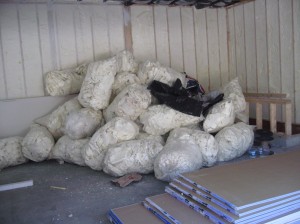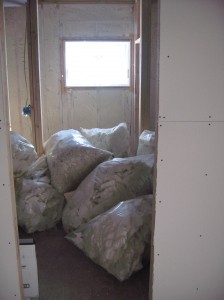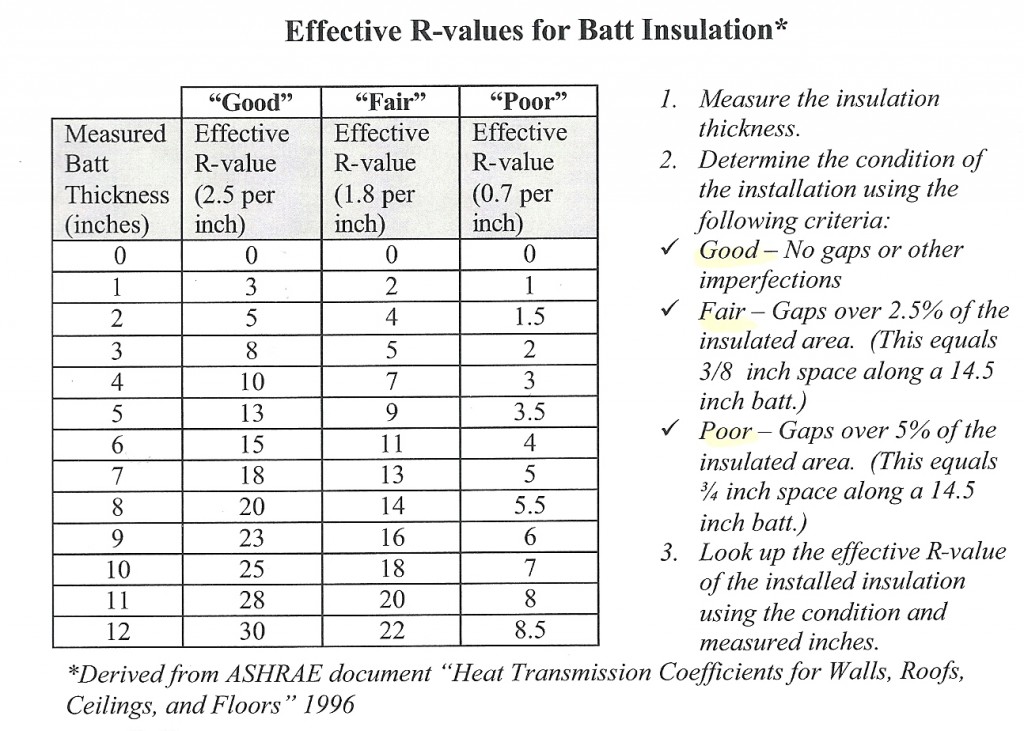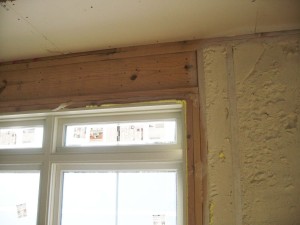Expanding spray foam insulation has become real popular.
Applying the spray foam is fast passed work. The applicator moves from bay to bay judging the proper amount that will quickly expand to the desired thickness. If the sprayer is moved too slowly then too much insulation will be installed. Also the applicator has to wear a pair of disposable coveralls, full head protection and a respirator that provides fresh air. They are often working in attics and crawl spaces . So getting the job done quickly is just the nature of the job.
As a drywall contractor I come in right after them or in some cases I hang ceilings and one side of a wall or two before they come. In addition I am a building performance analyst so I understand how well a good insulation job can perform. I understand that paying attention to the details can make or break any job. Just like when I tape a house, coating the screws around door and window openings is important because if the trim does not cover them later the job is compromised.
I can honestly say that I rarely see a foam insulation contractor that even comes close to offering the complete package (seal all gaps, prevent overspray, cover crucial area and clean up). Let’s face it the cost of spray foam is much higher than installing fiberglass or cellulose insulation. The cost of the chemicals used is quite high and of course the overhead is quite high. So I don’t think they are overcharging or making a killing financially. But from what I have seen so far I would like them to slow down a little and offer some quality.
The big selling point for using spray foam insulation is that the insulation fits tight around any framing and penetrations such as electrical boxes and plumbing. There should not be any gaps or unfilled areas that are difficult to avoid when insulating with fiberglass. Gaps greatly reduce the R value.
- I have seen window headers not insulated. I know it may be difficult to properly fill that 1 1/2’” space but it should be done.
- I rarely see window or exterior door jams foam insulated. Yes a simple hand held gun would have to be used instead of the big spray gun. So why not complete the job.
- What about smaller gaps between the framing or along the bottom plates of wall. Spray foam may not work in these areas at all. In order to offer the complete package they need to be sealed. All it takes is some some caulk to take care of those areas.
- Personally I would like the insulators to do a walk through after they think they are finished. In other words take the time to walk the entire job and make sure nothing was missed. Missing all these areas is to me the equivalent of painting a room with a roller and not cutting in any edges with a brush.
In photo to the left; notice the overspray on the ceiling, the un-insulated header, unsealed gapes in framing and along bottom plate, and sealed window jam and repairs in wall cavities that the building contractor had to do
What about prep to prevent overspray? Yes; when I hang and tape drywall the windows get dusty and some compound does end up on the jams, but I don’t leave the mess when I leave. I vacuum, sand, and wash or I risk having the painters mad at me. The spray foam stuff is not easy to clean off so preventing overspray from getting on windows or even floors in the first place is important. On the job I just finished taping I know the fiberglass tub and a shower unit were covered but not well enough. When I was cleaning the units after I finished sanding I noticed some major overspray not only along the edges but on the floors of the units. There is no way the customer is going to be happy about this. 
On this particular job open cell foam was installed in the walls and also in the ceilings joists (I hung the drywall first). The wall cavities were filled and the excess foam trimmed off with reciprocal saws that had long blades attached. When the job was done, the insulators swept up the waste and put it all in construction garbage bags and just left the bags there. When I came back to finishing hanging the drywall I asked about the bags of insulation and the contractor said that the insulators said they never take the waste with them. So I moved it all to the garage and eventually outside in the yard. I told the contractor that when I was done hanging the drywall I was just going to leave all the scrapes in piles and he would have to get rid of it himself. He just laughed so I loaded the drywal scrapes into my trailer and took it to the dump. The point is clean up after your mess. Another thing was that there was also overspray on the drywalled ceilings. What about using a spray shield?
So my question is why are these spray foam contractors allowed to do an incomplete job, make a mess, and leave garbage behind. It just isn’t fair. And before anyone says anything, I know that there are some that offer the complete package but I have not found one yet, at least in my area.


Really nice article.
Quality gets lost in the race to the bottom on price. GC’s and Homeowners should refer to this when building their spec for quote. I guess this is an example of caveat emptor.
Most foam guys think they are delivering a product rather than a solution. And if “air sealing” isn’t part of the job specification, maybe that is all they are providing.
Do the outside walls of a commercial building have to be drywalled right up to the deck when we are installing 5/8 drywall ceilings at 8′ after.
Depends on if the walls are part of a fire assembly, sound control assembly, or if necessary for air sealing. Should be in the job specks.
Myron
I don’t know what area you are working in, but I think that you are generalizing all spray foam applicators by judging a small number. We at Greener World Solutions pride ourselves with quality work such as sealing all gaps, preventing overspray, covering crucial areas and clean up. We also include FREE, insulating around all windows and doors. We caulk. We even tape the studs to make the drywallers job easier. Since we sweep up when we are finished, we typically leave the jobsite cleaner than when we started. We take our waste with us. We work hard at providing a quality job and I believe that most other spray foam insulators do, too.
I am located in upstate NY. It is interesting because you are the first to stick up for the insulators and the first insulator to respond. I am glad to hear that you take attention to details and cleanup seriously. Your company is truly providing a service. Unfortunately, I have not met any local companies who meet my expectations. Maybe it is because it is a pretty competitive market and because installers are not properly educated as to the importance of the details. I have been on jobs where the insulators did an excellent job sealing and caulking all gaps but have not done a good job trimming off the access foam. So note that I can’t install the drywall unless I spend the good part of the day trimming and then of course cleaning.
Whenever a process is paid for by the sq ft I believe quality control by a third part inspection is critical. Maybe the sq ft pricing is not the issue, maybe it is just that whenever attention to details is as critically important as when air sealing and insulating that quality inspections are important.
As contractors none of us really want someone following around behind us inspecting our work, but as we all strive to meet the new energy codes this will become more and more the norm. I think a lot of the quality control can be accomplished by the general contractor doing a better job. Of course general contractors are interested in the bottom line and tight schedules so they would not be the best choice as the third party inspector. I know for years insulation was just quickly inspected to make sure the proper R Value was installed with little concern for overall quality which we know has a huge effect on actual R value.
Anyways I know there are companies out there like yours who do excellent work, but I still think you are exception not the rule.
All the best,
Myton
It must be an Upstate NY thing! Born in Buffalo, and raised north of Syracuse in Watertown, I can not only relate but appreciate everything said here and in the article above. My husband and I moved two years ago from our four bedroom apartment in NY, into a four bedroom house in IN. We did not realize that moving only three states meant leaving behind “the details.” Houses here are not built well, and the improvements are never finished with pride. We have since taken matters into our own hands and become unsung DIY’ers. Thank you for posting this article. My gut told me to watch for everything you mentioned above; and it is helpful to know when talking over a project with any contractor, we are speaking the same language; and expecting the same outcome. Excellence is dying art. Thank you for being one of the few.
What’s the best way to remove foam beyond the wall studs after 2-part spray foam has cured? Is there a specific tool or roller? Just wondering…